Related Research Articles
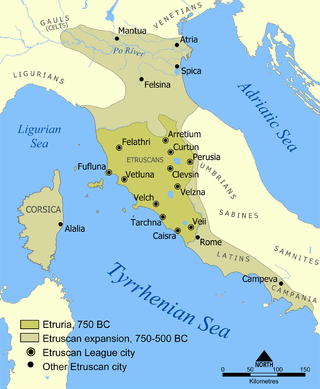
The Etruscan civilization was an ancient civilization created by the Etruscans, a people who inhabited Etruria in ancient Italy, with a common language and culture who formed a federation of city-states. After conquering adjacent lands, its territory covered, at its greatest extent, roughly what is now Tuscany, western Umbria, and northern Lazio, as well as what are now the Po Valley, Emilia-Romagna, south-eastern Lombardy, southern Veneto, and western Campania.
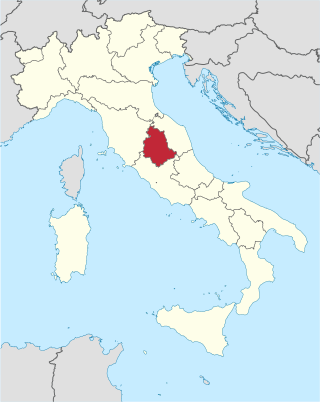
Umbria is a region of central Italy. It includes Lake Trasimeno and Marmore Falls, and is crossed by the Tiber. It is the only landlocked region on the Apennine Peninsula. The regional capital is Perugia.

Adria is a town and comune in the province of Rovigo in the Veneto region of northern Italy, situated between the mouths of the rivers Adige and Po. The remains of the Etruscan city of Atria or Hatria are to be found below the modern city, three to four metres below the current level. Adria and Spina were the Etruscan ports and depots for Felsina. Adria may have given its name during an early period to the Adriatic Sea, to which it was connected by channels.

The Falisci were an Italic tribe who lived in what is now northern Lazio, on the Etruscan side of the Tiber River. They spoke an Italic language, Faliscan, closely related to Latin. Originally a sovereign state, politically and socially they supported the Etruscans, joining the Etruscan League. This conviction and affiliation led to their ultimate near destruction and total subjugation by Rome.

The Veneti were an Indo-European people who inhabited northeastern Italy, in an area corresponding to the modern-day region of Veneto, from the middle of the 2nd millennium BC and developing their own original civilization along the 1st millennium BC.
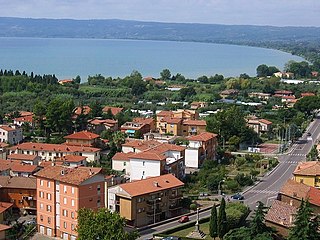
Volsinii or Vulsinii, is the name of two ancient cities of Etruria, one situated on the shore of Lacus Volsiniensis, and the other on the Via Clodia, between Clusium (Chiusi) and Forum Cassii (Vetralla). The latter was Etruscan and was destroyed by the Romans in 264 BC following an attempted revolt by its slaves, while the former was founded by the Romans using the remainder of the Etruscan population rescued from the razed city.
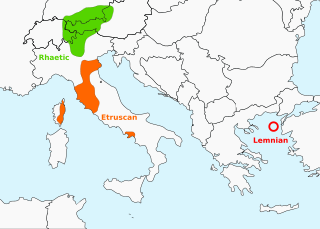
Rhaetic or Raetic, also known as Rhaetian, was a Tyrsenian language spoken in the ancient region of Rhaetia in the eastern Alps in pre-Roman and Roman times. It is documented by around 280 texts dated from the 5th up until the 1st century BC, which were found through northern Italy, southern Germany, eastern Switzerland, Slovenia and western Austria, in two variants of the Old Italic scripts. Rhaetic is largely accepted as being closely related to Etruscan.

The province of Terni is the smaller of the two provinces in the Umbria region of Italy, comprising one-third of both the area and population of the region. Its capital is the city of Terni. The province came into being in 1927, when it was carved out of the original unitary province of Umbria.

The Senones or Senonii were an ancient Gallic tribe dwelling in the Seine basin, around present-day Sens, during the Iron Age and the Roman period.
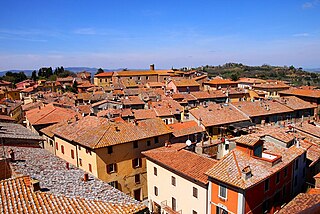
Chiusi is a town and comune in the province of Siena, Tuscany, Italy.

The Umbri were an Italic people of ancient Italy. A region called Umbria still exists and is now occupied by Italian speakers. It is somewhat smaller than the ancient Umbria.

Caere is the Latin name given by the Romans to one of the larger cities of southern Etruria, the modern Cerveteri, approximately 50–60 kilometres north-northwest of Rome. To the Etruscans it was known as Cisra, to the Greeks as Agylla and to the Phoenicians as 𐤊𐤉𐤔𐤓𐤉𐤀.
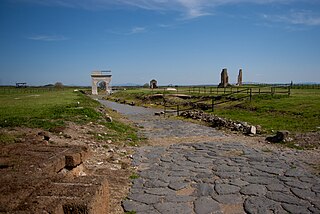
Vulci or Volci was a rich Etruscan city in what is now northern Lazio, central Italy.
The first Battle of Lake Vadimo was fought in 310 BC between Rome and the Etruscans, and ended up being the largest battle between these nations. The Romans were victorious, gaining land and influence in the region. The Etruscans sustained heavy losses in the battle and would never again reclaim their previous glory.

Orte is a town, comune, former Catholic bishopric and Latin titular see in the province of Viterbo, in the central Italian region of Lazio, located about 60 kilometres (37 mi) north of Rome and about 24 kilometres (15 mi) east of Viterbo.

Bassano in Teverina is a comune (municipality) in the Province of Viterbo in the Italian region of Latium. It is inhabited by 1,332 people and is located about 90 kilometres (56 mi) north of Rome and about 20 kilometres (12 mi) northeast of Viterbo. It is one of I Borghi più belli d'Italia.
Portus Julius was the first harbour specifically constructed to be a base for the Roman western naval fleet, the classis Misenensis. The port was located near Baiae and protected by the Misenum peninsula at the north-western end of the Gulf of Naples. Portus Julius was named in honour of Octavian's great-uncle and adoptive father, Julius Caesar and the Julian clan.

The Raeti were a confederation of Alpine tribes, whose language and culture was related to those of the Etruscans. Before the Roman conquest, they inhabited present-day Tyrol in Austria, eastern Switzerland and the Alpine regions of northeastern Italy. After the Roman conquest, the province of Raetia was formed, which included parts of present-day Germany south of the Danube.
The gens Caecinia was a plebeian family of Etruscan origin at ancient Rome. Members of this gens are first mentioned in the time of Cicero, and they remained prominent through the first century of the Empire, before fading into obscurity in the time of the Flavian emperors. A family of this name rose to prominence once more at the beginning of the fifth century.
The gens Lartia, also spelled Larcia, or rarely Largia, was a patrician family at ancient Rome, whose members earned great distinction at the beginning of the Republic. Spurius Larcius was one of the two companions of Horatius, who defended the Pons Sublicius against Lars Porsena in 508 BC. A few years later, Titus Larcius became the first Roman dictator. However, the gens all but vanishes from history after this period. A family of the same name existed in the late Republic and under the early Empire, but their relationship to the earlier Lartii is unknown.
References
- ↑ Cf. The True Story of Lake Vadimo (in Italian) - also called Lake Vadimone, or in Italian: Lago Vadimone.
- ↑ The area was inhabited from the 6th century BC and called *Hurta: cf. Chiesa, Tarquinia: archeologia e prosopografia tra ellenismo e romanizzazione , 2006, p.267. — as testified by the findings in a necropolis nearby, now preserved in the Vatican Museums.
- ↑ John Murray, A dictionary of Greek and Roman geography, Volume 1 , 1873, p.1091
- ↑ Firth, J.B. "Pliny the Younger:Letters" . Retrieved 2023-08-14.
42°29′03″N12°19′24″E / 42.4842°N 12.3232°E